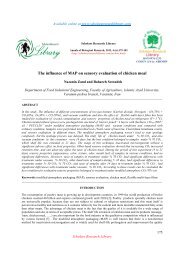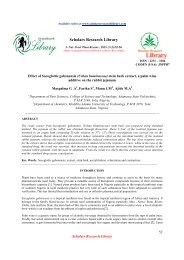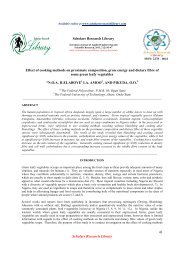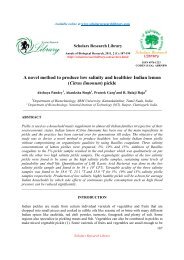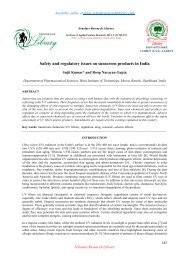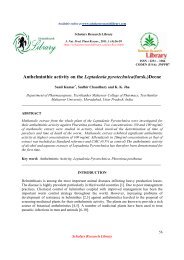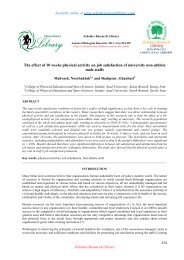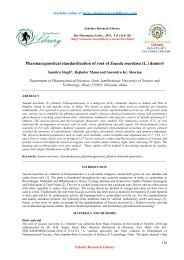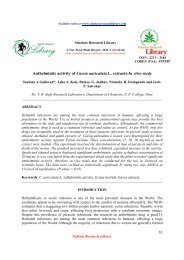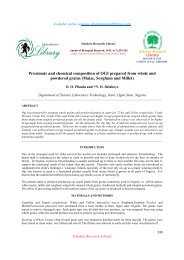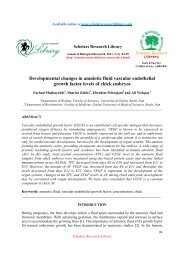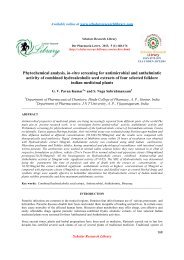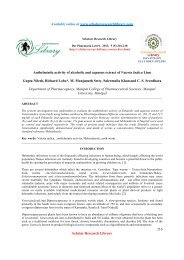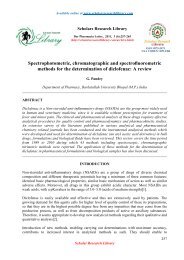Regulation for safety and quality of cosmetics vis - Scholars ...
Regulation for safety and quality of cosmetics vis - Scholars ...
Regulation for safety and quality of cosmetics vis - Scholars ...
Create successful ePaper yourself
Turn your PDF publications into a flip-book with our unique Google optimized e-Paper software.
Sujit Kumar et al Der Pharmacia Lettre, 2012, 4 (1):181-191<br />
_____________________________________________________________________________<br />
market. Indian cosmetic industries continue to be a beautiful blend <strong>of</strong> traditional <strong>and</strong> modern like<br />
kajal, sindoor, kum-kum, herbal <strong>cosmetics</strong>, lipsticks, nail polishes etc. The aim <strong>of</strong> the present<br />
article is to compare the regulations in EU, USA, Canada, ASEAN nations <strong>and</strong> India <strong>for</strong><br />
cosmetic colourants with respect to labelling, nomenclature, <strong>safety</strong> <strong>and</strong> thereby <strong>quality</strong> <strong>of</strong> the<br />
products to the end users <strong>and</strong> includes the following aspects.<br />
COSMETICS COLOUR LABELLING<br />
EU<br />
In the EU, the regulatory framework is provided by the Cosmetics Directive (76/768/EEC) <strong>and</strong><br />
its subsequent amendments. Colouring agents may be listed in any order after the other<br />
ingredients using the Colour Index Number or denomination adopted in Annex IV. For<br />
decorative <strong>cosmetics</strong> marketed in several colour shades, all colouring agents used in the range<br />
may be listed preceded by the words “may contain” or the symbol “+/-” [2, 3].<br />
The <strong>Regulation</strong>s make pro<strong>vis</strong>ion <strong>for</strong> the listing <strong>of</strong> all colouring agents used in a decorative<br />
<strong>cosmetics</strong> although each product would only contain a selection <strong>of</strong> those colours. The intention is<br />
to simplify manufacture by allowing all <strong>of</strong> the colouring agents to be listed on one label in a<br />
market where fashions <strong>and</strong> colours change frequently. Ingredient listing is required on the outer<br />
packaging only or, in its absence, on the primary container. Where it is impossible <strong>for</strong> practical<br />
reasons <strong>for</strong> the list to appear on the packaging (or container), it is required to be given on a<br />
leaflet, label, tag, tape or card enclosed with the product or attached to it. Colour ingredients<br />
which do not have a CI number, <strong>and</strong> not listed in the above <strong>Regulation</strong>s, but are closely<br />
associated with colour might only be present in some products within the decorative range.<br />
These items are mentioned under the +/- (may contain) section <strong>of</strong> the ingredient listing like mica<br />
<strong>and</strong> tin oxide, both used as opacifiers.<br />
US<br />
The cosmetic product ingredients labelling are regulated by the Federal Food, Drug <strong>and</strong><br />
Cosmetic Act, as amended (FFDCA) <strong>and</strong> its implementing regulations. The Fair Packaging <strong>and</strong><br />
labelling Act, as amended (FPLA) <strong>and</strong> its implementing regulations are also considered.<br />
Ingredients other than colours present at a concentration exceeding 1% in descending order or<br />
predominance, followed by ingredients other than colours present at 1% or less in any order,<br />
followed by colours present at any concentration listed in any order. The colour additives<br />
common to all shades must be listed be<strong>for</strong>e “May contain”, <strong>and</strong> only those not found in all shade<br />
<strong>for</strong>mulations may be listed after “May contain” [4].<br />
FFDCA defines a colour additive as a material which –(a) is a dye, pigment or other substance<br />
made by a process <strong>of</strong> synthesis or similar artifice, or extracted, isolated or otherwise derived,<br />
with or without immediate or final change <strong>of</strong> identity, from a vegetable, animal, mineral or other<br />
source, <strong>and</strong> (b) when added or applied to a food, drug or cosmetic, or to the human body or any<br />
part there<strong>of</strong>, is capable (alone or through reaction with other substance) <strong>of</strong> imparting colour<br />
thereto.......The term colour includes black, white <strong>and</strong> intermediate grays.<br />
ASEAN<br />
ASEAN (Association <strong>of</strong> South East Asian Nations) nations, a group <strong>of</strong> ten countries, follow<br />
ASEAN Cosmetic Directive which defines “colour” as a substance used as an ingredient <strong>of</strong><br />
cosmetic product solely to give tonality to the product. Variants are defined (a range <strong>of</strong> cosmetic<br />
products) as similar in composition but differs in colours, flavours etc. - produced by the same<br />
manufacturer, <strong>and</strong> are intended <strong>for</strong> the same use but are available in different shades <strong>of</strong> colour<br />
(e.g. lipsticks, eye shadows or nail polish but not composite packs <strong>of</strong> different types). These are<br />
Scholar Research Library<br />
182



